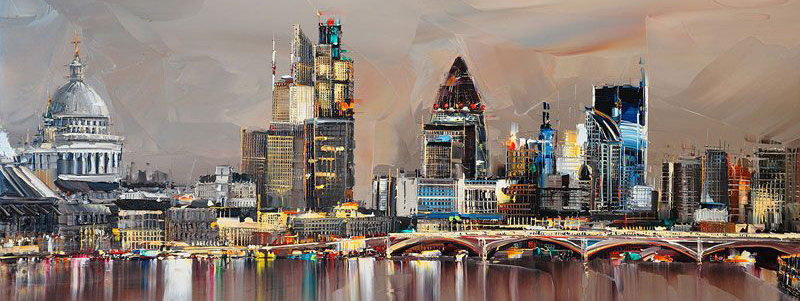London is like a sea; once you take a dip, all you need do is allow the tides to carry you gently adrift. These currents can sometimes be friendly, less so in other moments. At times, you may be overwhelmed by the din and commotion of the cars, the rumbling of the city buses, or the music blaring in the shops...
However, when it feels like all of it is simply too much to bear any longer, there is always a remedy at hand: a park, a garden, a green area sporting a comfortable bench to sit on and relax. True as it may be that often the weather is unhelpful, it must be said that in exchange it keeps the grass nice and green and spurs the growth of huge plane trees, chestnut trees and sycamores. Yet when the weather does play up, there is always some quaint uncharted library, an eccentric museum, or a splendid tearoom, all waiting to be found, all hidden spots of “the other London”, which are available to the inquisitive traveller.

Undeterred by rapid developments, the city continues to comprise many different towns, each with its own centre. Despite the towers clad in glass and steel, which clutch at the skies, London is nevertheless still largely a “horizontal” city, consisting mainly of houses with low roofs and gardens, with neighbours to one’s sides and not above or below. It is a patchy, mottled city: there are the more elegant neighbourhoods boasting apartments at stellar prices, which are built around squares riddled with gardens, where during summertime the notes of Haydn and Liszt resound. Then there are the seedy run-down areas, where the buildings have been disfigured by graffiti, where the squares are filthy and the benches are damaged. All around, modern architecture co-exists alongside that of times gone by; newer buildings loom over the medieval crypts and Norman churches, and contemporary works of sculpture embellish the facades of Sixteenth-century villas. London is a metropolis which looks to the future, and has more than once arisen from its own ashes, from the times of the Great Fire to the bombardments.

The inhabitants of local origin live alongside foreigners who come from South America, Africa, Asia or Australia, and such a melting pot makes the streets colourful, journeys in the tube interesting, and visits to the pub pleasurable. Each day has one fascinated, amused, and at times bewildered by the sight of these eight-million people living elbow to elbow. One may often witness striking scenes and hear unusual accents, and then head home feeling enlightened by the experience, running the events through one’s mind. In this place, the cradle of the English language, the majority of the people speaking it are not of English origin. Many of them have an original way of building phrases, and the personal use of idiomatic expressions enhances the element of humour.
In this place, the cradle of the English language, the majority of the people speaking it are not of English origin. Many of them have an original way of building phrases, and the personal use of idiomatic expressions enhances the element of humour.
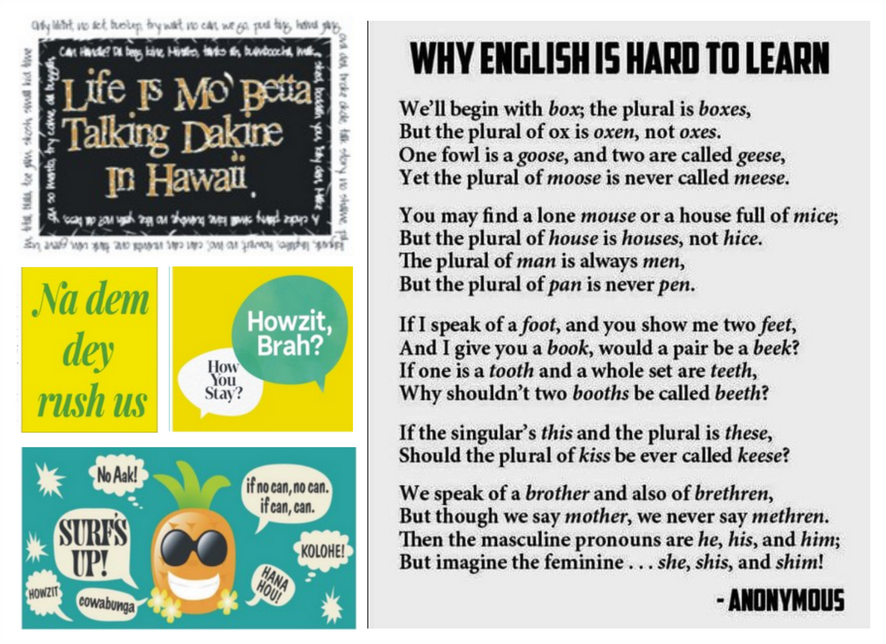
London is a city of complexity and contradictions, yet it is also full of charm and vitality, and offers a great deal. The big museums, located within awe-inspiring buildings, are evidence of its past opulence as the capital of a vast empire. Art galleries host top artists and emerging ones. There are more than one hundred and fifty theatres, which have a selection of shows unequalled elsewhere and the same can be said for cinemas and concert halls. One comes across open-air shows, festivals which take place on the banks of the Thames, dancing to the rhythm of music brought over from India, Brazil or other countries, and parades on the Thames... What is more, London continues to be a fountain of new fashion trends and has a variety of cuisines that is simply unbeatable.
Also impressive is the number and quality of newspapers or magazines that come out every day in different languages. Not to mention the quantity of books to be found in shops and at stalls, which can be new, second-hand, valuable, half-priced, classics, contemporary novels, poetry books, you name it... This is a city which also offers a lot to children and young people: the South Bank puppet theatre or the video screenings held at the Tate Gallery, where a post has been set up for observing the peregrine falcons which have made their nest in the chimney opposite, and let’s not forget the enactment of comedies written by eleven-year-olds...

One may also visit the city by pursuing a chosen theme: not just art galleries, but also sundials, pottery collections, old signposts, stone bestiaries, gardens, embroidery, the list goes on... There are bizarre scenes, such as the stone skulls placed atop the gates of the old St. Olave cemetery; there are mysterious objects, like the statue of King Ludd in Fleet Street, and oddities like ambulance stretchers used to build garden gateways; we can admire the pastel colour of the prefabricated houses which date back to the post-war period, and the lighthouse, the only one left, different to the ones we are used to.

Original architectural details adorn the facades of buildings, and one may admire the nude statues of Zimbabwe House, visit the splendid Victorian mansion which hosts a water-pumping station, or see the colourful wall paintings. It is also lovely to walk along the side of the canals, surrounded by nature, and in the company of the herons, intent on their fishing.
Like Rome, London stands atop a group of hills. One of them is Parliament Hill, in Hampstead, from which one can enjoy a wonderful view of the city’s most famous spots. Another is Primrose Hill, slightly to the south of the Parliament Hill, with its pretty view looking over Regent s Park. Then we find Muswell Hill, rich with water, where the Thames and the Lea river can be admired. There is a hillside park known as Alexandra Palace, which includes a big building, an example of Victorian architecture, and an ice rink... Also the southern part of the city is hilly. Here we find the slopes of Brixton’s Brockwell Park, with its spectacular lakes, worthy of being the subject of postcards, centuries-old trees, and Denmark Hill, named in honour of Queen Anne, wife of George, prince of Denmark.

Two more hills are Forest Hill, where the Horniman Museum lies, and Greenwich Park hill, which ascends from the Thames with a breathtaking view over the buildings of Wren and Hawksmoor. Shooters Hill is where those condemned to hanging would once be publically displayed, and today it is where the Victorian water tower, is found. London is also a lush city, rich with greenery. From the royal parks of the center, and the Jubilee Gardens with their geometric flower beds, to Richmond Park, the fields of Wimbledon, and the woods in Epping Forest, there are miles and miles of grass and flowers amid which to walk. Of course these flowers change with the seasons, with endless stretches of crocus in February, daffodils in the Spring, the hydrangeas and dahlias in the Summer, and roses almost all year round. There are also animals in the parks: in Regent’s Park sheep graze, in the Serpentine ducks delve, all along Westbourne hawks hunt for mice…
As well as the large green areas in the parks, there are the smaller gardens and the old shady graveyards, to be found even in areas of great urban concentration such as the City, where many of office windows are stroked by the leafy tree branches. The instinct to sow seeds and plant shoots to watch them grow and flourish into plants is very strong in the English people because as they like to say, it’s nice to have “a bit of green” around, giving one the impression of being in the country. So what better than to make one's way into the parks, slip into a tree-lined square, or follow one of the evocative paths along the riverside...
London has always been an international city which has welcomed immigrants and refugees from all over the world. In the Seventeenth Century, those persecuted for religious reasons arrived from Spain and Holland. In the Eighteenth Century, the Huguenots and political intellectuals such as Voltaire made their way over. The same can be said for Nineteenth Century Italy, during which Mazzini arrived there. Karl Marx arrived from Germany and was later to analyze British industrial capitalism and write Das Capital.

It was especially during the Twentieth Century that a certain phenomenon started, namely that of mass immigration from European countries which had severe internal problems. Many came: Germans, Austrians, Italians, Spanish, and Eastern Europeans. Italian intellectuals would meet in Soho cafés, the Russians instead would rendezvous at Primrose Hill, at the Herzen club. Torn from their land, with all of their belongings packed into a suitcase, not knowing the local language, and subject to humiliation and intricate bureaucratic procedures, these immigrants would try their hardest to integrate in the shortest time possible. They opened new restaurants, new shops, they tried to become somewhat English themselves, but often found themselves somewhere in the middle, with their native countries still firmly etched in their minds. The city, at any rate, accepted new habits and schedules, as well as political and intellectual provocations on the part of the foreigners. In more recent years came the Cypriots, Indians, Pakistanis, Chinese, and West Indians.
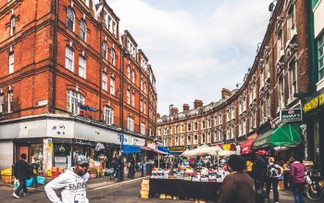 They went to live in Brixton, Deptford, and Camden Town, where there are entire neighbourhoods inhabited by immigrants. The International and cosmopolitan city of London would absorb all those who passed that way. Today this huge and complex metropolis is a home to many different cultures and languages. At the newsagents’, in addition to newspapers in English and the main European languages, one can also find newspapers and magazines in Arab, Hindi, and Chinese. These different cultures are also apparent in the architecture of the buildings and the items safeguarded by museums, which is where the heritage of what used to be the British empire is found. In the city that was once the incarnation of tradition and austerity, behaviour and lifestyles have changed. Today London is an avant-garde metropolis, where fashions and new styles bloom as a consequence of the different cultures that make up the city.
They went to live in Brixton, Deptford, and Camden Town, where there are entire neighbourhoods inhabited by immigrants. The International and cosmopolitan city of London would absorb all those who passed that way. Today this huge and complex metropolis is a home to many different cultures and languages. At the newsagents’, in addition to newspapers in English and the main European languages, one can also find newspapers and magazines in Arab, Hindi, and Chinese. These different cultures are also apparent in the architecture of the buildings and the items safeguarded by museums, which is where the heritage of what used to be the British empire is found. In the city that was once the incarnation of tradition and austerity, behaviour and lifestyles have changed. Today London is an avant-garde metropolis, where fashions and new styles bloom as a consequence of the different cultures that make up the city.From the ancient Romans until today. The Italian side of London – 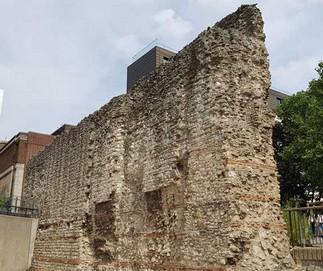 It was the year 35 b.C. when Julius Caesar landed on the coasts of Kent leading the Roman army, and it was in 43 a.D. that emperor Claudio built a bridge on the Thames and created a fortified settlement north of the river, which was baptized Londinium. Centuries later, the missionary monks arrived, and contributed to spreading Christianity throughout the country. The following phase during which Italy was involved in British affairs was between the 13th and 14th centuries, when Italian markets and bankers played an important role in local trade and finance. They would operate in Lombard street, named so because of the fact that most of the bankers were originally from Lombardy. Also the word ‘bankrupt’ derives from the Italian term ‘bancarotta’. The name refers to the tradition of breaking the counters (banchi) of bankers who had gone bankrupt or become insolvent. The three golden balls, instead, are a symbol of money lent on pledge, and derives from the crest of the Medici. During the Renaissance there was an invasion of Italian art and culture: architects, painters, sculptors, artists, artisans, scholars, opera singers, and dance teachers would arrive in great numbers… Together with this elite emigration from Italy, there was the mass of people emigrating in order to escape their misery: peddlers, concertina players and street performers. In 1806 the clown Joseph Grimaldi became famous in pantomimes. Among the shows that left their mark on British culture, was that of the puppets known as Punch and Judy, derived from the mask of Pulcinella. A plate on the left side of St Paul’s Church in Covent Garden, indicates the place where the puppet master Pietro Gimondi, in May 1662, used to put on a puppet show which caught the enthusiasm of Samuel Pepys.
It was the year 35 b.C. when Julius Caesar landed on the coasts of Kent leading the Roman army, and it was in 43 a.D. that emperor Claudio built a bridge on the Thames and created a fortified settlement north of the river, which was baptized Londinium. Centuries later, the missionary monks arrived, and contributed to spreading Christianity throughout the country. The following phase during which Italy was involved in British affairs was between the 13th and 14th centuries, when Italian markets and bankers played an important role in local trade and finance. They would operate in Lombard street, named so because of the fact that most of the bankers were originally from Lombardy. Also the word ‘bankrupt’ derives from the Italian term ‘bancarotta’. The name refers to the tradition of breaking the counters (banchi) of bankers who had gone bankrupt or become insolvent. The three golden balls, instead, are a symbol of money lent on pledge, and derives from the crest of the Medici. During the Renaissance there was an invasion of Italian art and culture: architects, painters, sculptors, artists, artisans, scholars, opera singers, and dance teachers would arrive in great numbers… Together with this elite emigration from Italy, there was the mass of people emigrating in order to escape their misery: peddlers, concertina players and street performers. In 1806 the clown Joseph Grimaldi became famous in pantomimes. Among the shows that left their mark on British culture, was that of the puppets known as Punch and Judy, derived from the mask of Pulcinella. A plate on the left side of St Paul’s Church in Covent Garden, indicates the place where the puppet master Pietro Gimondi, in May 1662, used to put on a puppet show which caught the enthusiasm of Samuel Pepys.
 It was the year 35 b.C. when Julius Caesar landed on the coasts of Kent leading the Roman army, and it was in 43 a.D. that emperor Claudio built a bridge on the Thames and created a fortified settlement north of the river, which was baptized Londinium. Centuries later, the missionary monks arrived, and contributed to spreading Christianity throughout the country. The following phase during which Italy was involved in British affairs was between the 13th and 14th centuries, when Italian markets and bankers played an important role in local trade and finance. They would operate in Lombard street, named so because of the fact that most of the bankers were originally from Lombardy. Also the word ‘bankrupt’ derives from the Italian term ‘bancarotta’. The name refers to the tradition of breaking the counters (banchi) of bankers who had gone bankrupt or become insolvent. The three golden balls, instead, are a symbol of money lent on pledge, and derives from the crest of the Medici. During the Renaissance there was an invasion of Italian art and culture: architects, painters, sculptors, artists, artisans, scholars, opera singers, and dance teachers would arrive in great numbers… Together with this elite emigration from Italy, there was the mass of people emigrating in order to escape their misery: peddlers, concertina players and street performers. In 1806 the clown Joseph Grimaldi became famous in pantomimes. Among the shows that left their mark on British culture, was that of the puppets known as Punch and Judy, derived from the mask of Pulcinella. A plate on the left side of St Paul’s Church in Covent Garden, indicates the place where the puppet master Pietro Gimondi, in May 1662, used to put on a puppet show which caught the enthusiasm of Samuel Pepys.
It was the year 35 b.C. when Julius Caesar landed on the coasts of Kent leading the Roman army, and it was in 43 a.D. that emperor Claudio built a bridge on the Thames and created a fortified settlement north of the river, which was baptized Londinium. Centuries later, the missionary monks arrived, and contributed to spreading Christianity throughout the country. The following phase during which Italy was involved in British affairs was between the 13th and 14th centuries, when Italian markets and bankers played an important role in local trade and finance. They would operate in Lombard street, named so because of the fact that most of the bankers were originally from Lombardy. Also the word ‘bankrupt’ derives from the Italian term ‘bancarotta’. The name refers to the tradition of breaking the counters (banchi) of bankers who had gone bankrupt or become insolvent. The three golden balls, instead, are a symbol of money lent on pledge, and derives from the crest of the Medici. During the Renaissance there was an invasion of Italian art and culture: architects, painters, sculptors, artists, artisans, scholars, opera singers, and dance teachers would arrive in great numbers… Together with this elite emigration from Italy, there was the mass of people emigrating in order to escape their misery: peddlers, concertina players and street performers. In 1806 the clown Joseph Grimaldi became famous in pantomimes. Among the shows that left their mark on British culture, was that of the puppets known as Punch and Judy, derived from the mask of Pulcinella. A plate on the left side of St Paul’s Church in Covent Garden, indicates the place where the puppet master Pietro Gimondi, in May 1662, used to put on a puppet show which caught the enthusiasm of Samuel Pepys.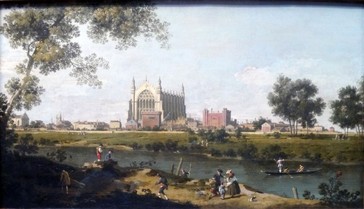 In the Eighteenth Century, many English travelers would go to visit Venice and from the lagoon city, they took a souvenir with them: a painting by Antonio Canal, better known as Canaletto. However unfortunately, after the Austrian War of Succession of 1740,travelers had become rarer. And therefore what did Canaletto decide to do? He set off and went to live in London, at number 41 in Beak Street. Maintaining the style which he had used to portray Venice, he started to paint London and, in particular, the Thames. Some of his paintings are exhibited at the National Gallery, others are part of the Wallace Collection. However experts do not consider them amongst his greatest works. Another famous Venetian was Giacomo Casanova: born in 1725, son of a couple who were actors, he arrived in London in 1763. His intention was that of setting up a lottery, however this proved to be more difficult than he had anticipated. Casanova would meet illustrious characters, such as King George III and the writer Samuel Johnson, and spent the evenings going to the theatre and attending public bathrooms, where appeasing women were to be found. He also ended up in prison on one occasion, for having attempted to assault Marianne Charpillon, with whom he had fallen in love with and who had extorted huge amounts of money from him. Once out of jail, he had taught a parrot to say: “Charpillon is a wh….””, then he had entrusted it to his servant, who had been instructed to walk around the centre of town with it. He later was forced to hurriedly abandon London altogether, owing to the fact that he had cashed in a false credit note, which he had received by winning a game of dice.
In the Eighteenth Century, many English travelers would go to visit Venice and from the lagoon city, they took a souvenir with them: a painting by Antonio Canal, better known as Canaletto. However unfortunately, after the Austrian War of Succession of 1740,travelers had become rarer. And therefore what did Canaletto decide to do? He set off and went to live in London, at number 41 in Beak Street. Maintaining the style which he had used to portray Venice, he started to paint London and, in particular, the Thames. Some of his paintings are exhibited at the National Gallery, others are part of the Wallace Collection. However experts do not consider them amongst his greatest works. Another famous Venetian was Giacomo Casanova: born in 1725, son of a couple who were actors, he arrived in London in 1763. His intention was that of setting up a lottery, however this proved to be more difficult than he had anticipated. Casanova would meet illustrious characters, such as King George III and the writer Samuel Johnson, and spent the evenings going to the theatre and attending public bathrooms, where appeasing women were to be found. He also ended up in prison on one occasion, for having attempted to assault Marianne Charpillon, with whom he had fallen in love with and who had extorted huge amounts of money from him. Once out of jail, he had taught a parrot to say: “Charpillon is a wh….””, then he had entrusted it to his servant, who had been instructed to walk around the centre of town with it. He later was forced to hurriedly abandon London altogether, owing to the fact that he had cashed in a false credit note, which he had received by winning a game of dice. 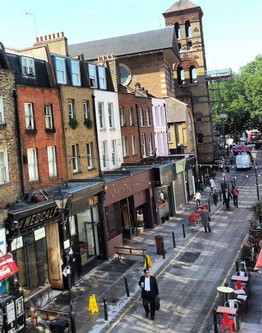 During the decade 1850-1860 political refugees arrived, and by the end of the century, the neighbourhoods of Clerkenwell and Holborn – and especially the building blocks between Rosebery Avenue, Farringdon Road, and Clerkenwell Road – were inhabited mostly by Italians. The centre of the settlement was around St Peter’s Church, between Black Hill, Eyre Street Hill and Summers Street. The church, which had been opened in 1863, is at the address of 4, Black Hill. It is modeled on S. Crisogono in Trastevere, Rome, and has a bronze statue of St Pierro, and one of its founder, St. Vincenzo Pallotti. Still today it continues to be a point of reference for the community; weddings and funerals are celebrated there, and the mass on Sundays attracts many visitors. Each year, on the 16th July, a procession takes place and carries the statue of Our Lady of Mount Carmel. The neighbourhoods where the immigrants used to live were poor, yet they had exported the Mediterranean way of life there. Life’s stage was the streets, men would play cards and smoke pipes, women would knitting away or cooking.
During the decade 1850-1860 political refugees arrived, and by the end of the century, the neighbourhoods of Clerkenwell and Holborn – and especially the building blocks between Rosebery Avenue, Farringdon Road, and Clerkenwell Road – were inhabited mostly by Italians. The centre of the settlement was around St Peter’s Church, between Black Hill, Eyre Street Hill and Summers Street. The church, which had been opened in 1863, is at the address of 4, Black Hill. It is modeled on S. Crisogono in Trastevere, Rome, and has a bronze statue of St Pierro, and one of its founder, St. Vincenzo Pallotti. Still today it continues to be a point of reference for the community; weddings and funerals are celebrated there, and the mass on Sundays attracts many visitors. Each year, on the 16th July, a procession takes place and carries the statue of Our Lady of Mount Carmel. The neighbourhoods where the immigrants used to live were poor, yet they had exported the Mediterranean way of life there. Life’s stage was the streets, men would play cards and smoke pipes, women would knitting away or cooking.During the years of fascism, Mussolini had sustained the Italian community, funded a school, held reception events, and distributed presents at Christmas.
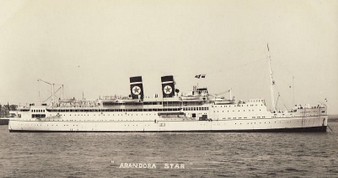 Although not all those who accepted these gifts were fascists, on June 10th 1940, when Mussolini declared war on Great Britain, any men, whether or not they still had Italian citizenship or had acquired British status, were internalised. Many were deported to the Isle of Man and placed in fields sealed off by barbed wire, others were taken to Australia and Canada. On July 2nd 1940, the ship Arandora Star, which was transporting six hundred and ten Italians and about as many Germans, was sunken by a German submarine. Four hundred and seventy of them perished. A plate outside the church of St Peters was placed in their memory and that of those fallen during the First World War. A number of those prisoners were able to regain their citizenship only later, in 1946 and decided to remain in Great Britain, in spite of the hostility towards them, especially on the part of British who had lost their relatives in the battles in North Africa. Italian immigration started again in 1950, and lasted another twenty years; Italians worked mainly in the restaurant sector. Statistics tell us that there are to date about two hundred and fifty thousand Italians living in London, however the flow of migration is now quite modest.
Although not all those who accepted these gifts were fascists, on June 10th 1940, when Mussolini declared war on Great Britain, any men, whether or not they still had Italian citizenship or had acquired British status, were internalised. Many were deported to the Isle of Man and placed in fields sealed off by barbed wire, others were taken to Australia and Canada. On July 2nd 1940, the ship Arandora Star, which was transporting six hundred and ten Italians and about as many Germans, was sunken by a German submarine. Four hundred and seventy of them perished. A plate outside the church of St Peters was placed in their memory and that of those fallen during the First World War. A number of those prisoners were able to regain their citizenship only later, in 1946 and decided to remain in Great Britain, in spite of the hostility towards them, especially on the part of British who had lost their relatives in the battles in North Africa. Italian immigration started again in 1950, and lasted another twenty years; Italians worked mainly in the restaurant sector. Statistics tell us that there are to date about two hundred and fifty thousand Italians living in London, however the flow of migration is now quite modest." It is commonly said, even by the English themselves, that English cooking is the worst in the world. It is supposed to be not merely incompetent, but also imitative...” wrote George Orwell. Yet simultaneously, the author seems to state the opposite as he goes on to say: “here are the delicacies that these lands offer: kippers, muffins and crumpets, Yorkshire pudding, Devonshire cream, flatbreads, Christmas pudding, treacle tart,
apple dumplings, the cakes – amongst which dark plum cake – pastry, saffron buns, and the countless types of biscuits…” Perhaps the main flaw in English cooking is not that of being imitative, but that of not being enormously varied. This does not mean that the cuisine is entirely reduced to fìsh and chips, in other words pieces of fried cod sold in paper cones with chips garnished with vinegar and ketchup, to be eaten whilst walking on the street.
For a start, traditional breakfast is tasty and abundant, and it is jokingly said that to eat well in England, it is enough to have breakfast three times a day. Breakfast typically consists of bacon and eggs, with buttered toast, to which one may add marmalade, a jam made from the oranges of Seville, which is bitter because it is rich in pectin from the fruit. Soft buns cooked on a metal slab, to be eaten hot and with butter spread on them, are accompanied by scrambled or poached eggs. Unfortunately, in the capital these traditions have often been lost, and it is not easy to find genuine English cooking. The development which came with the industrial revolution, the introduction of women into the workforce, and the ever-quickening pace of life gradually brought about the need for speedy and basic meals. In fact, one of the disadvantages of traditional cuisine is that unfortunately it requires a long time to prepare. Moreover, many restaurants that claim to serve traditional cuisine in truth offer a mix of continental dishes.
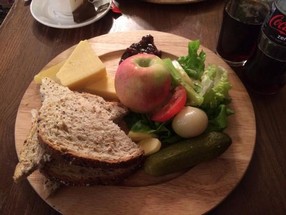 On the other hand, a whole meal in an English restaurant can be rather costly. It is all about choosing the proper area of the city, according to what type of meal one wishes to eat. For some good roast beef or pudding one should visit a pub, where one can also find another typical dish, known as ploughman's lunch, based on cheddar cheese, pickled onions, buttered bread, and mustard. Also found in pubs is pie and mash, a minced meat pie, served with white sauce flavoured with parsley. Another traditional dish is jellied eels, which are eels boiled with nutmeg and lemon sauce: while they cook they release a form of gelatin which solidifies once it has cooled down. This traditional dish is usually consumed in an equally traditional place, a venue with white bricks and marble floor. In the pubs in Greenwich and in those along the Thames one can taste the specialties based on fish. Here one can enjoy salmon served on slices of wholemeal bread, or soup made from fillets of white fish and enriched with parsley and white wine.
On the other hand, a whole meal in an English restaurant can be rather costly. It is all about choosing the proper area of the city, according to what type of meal one wishes to eat. For some good roast beef or pudding one should visit a pub, where one can also find another typical dish, known as ploughman's lunch, based on cheddar cheese, pickled onions, buttered bread, and mustard. Also found in pubs is pie and mash, a minced meat pie, served with white sauce flavoured with parsley. Another traditional dish is jellied eels, which are eels boiled with nutmeg and lemon sauce: while they cook they release a form of gelatin which solidifies once it has cooled down. This traditional dish is usually consumed in an equally traditional place, a venue with white bricks and marble floor. In the pubs in Greenwich and in those along the Thames one can taste the specialties based on fish. Here one can enjoy salmon served on slices of wholemeal bread, or soup made from fillets of white fish and enriched with parsley and white wine. 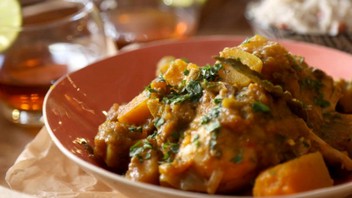 If one just wishes to grab a quick snack of simple food, one should head to a market. For example in Portobello Road, depending on the time of day, one can order a piping hot coffee with a bourbon, a biscuit with chocolate filling, or a Jaffa cake, a soft biscuit covered with chocolate-coated orange jam, on a cold afternoon it is possible to drink delicious-smelling vin brulé, and if the desire is that of something exotic, one can relish the taste of marinated spicy chicken, cooked on a grill and served with rice and pineapple, a traditional recipe from the Caribbean. Or one can try a slice of chorizo, spicy Spanish sausage also to be found at Borough Market, where it is cooked sauté in a frying pan.
If one just wishes to grab a quick snack of simple food, one should head to a market. For example in Portobello Road, depending on the time of day, one can order a piping hot coffee with a bourbon, a biscuit with chocolate filling, or a Jaffa cake, a soft biscuit covered with chocolate-coated orange jam, on a cold afternoon it is possible to drink delicious-smelling vin brulé, and if the desire is that of something exotic, one can relish the taste of marinated spicy chicken, cooked on a grill and served with rice and pineapple, a traditional recipe from the Caribbean. Or one can try a slice of chorizo, spicy Spanish sausage also to be found at Borough Market, where it is cooked sauté in a frying pan. 
It is inevitable that London is ruled by the fast food trend, due to the fact that restaurants must tend to the needs of the working locals, who are given a short lunch break and rush to eat their single-dish meals on the grass or benches of the parks as soon as they catch a glimpse of a ray of sunlight. Of course, this way of having lunch translates into a loss of conviviality, but the lunch break does not allow for any more than this. It was in fact the English themselves that made an art of the quintessence of fast food: the sandwich. In no other country is there such a great variety of types of bread and fillings as there is here. There are buns with cumin seeds, filled with hot sausages, others made with rye flour with the blue-veined Wensleydale cheese in them, or huge hunks of rustic bread hiding a juicy slice of rosy roast beef within, spread with horseradish and with a side dish of pickles… but the real classic amongst sandwiches is the BLT - Bacon Lettuce Tomato. 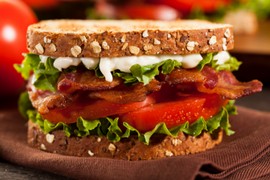 It is not only the commuters at lunch time who eat so speedily. In fact, at six in the afternoon, people heading toward the theatre usually eat a quick and light meal followed by a nice hot apple pie. The same happens after the show ends.
It is not only the commuters at lunch time who eat so speedily. In fact, at six in the afternoon, people heading toward the theatre usually eat a quick and light meal followed by a nice hot apple pie. The same happens after the show ends.
 It is not only the commuters at lunch time who eat so speedily. In fact, at six in the afternoon, people heading toward the theatre usually eat a quick and light meal followed by a nice hot apple pie. The same happens after the show ends.
It is not only the commuters at lunch time who eat so speedily. In fact, at six in the afternoon, people heading toward the theatre usually eat a quick and light meal followed by a nice hot apple pie. The same happens after the show ends. And since London is an international city, each neighbourhood, depending on the prevalent ethnic group, offers various types of excellent Indian cuisine, for example chicken curry, as well as delicacies from other cultures, whether Chinese, Mexican, or Japanese.
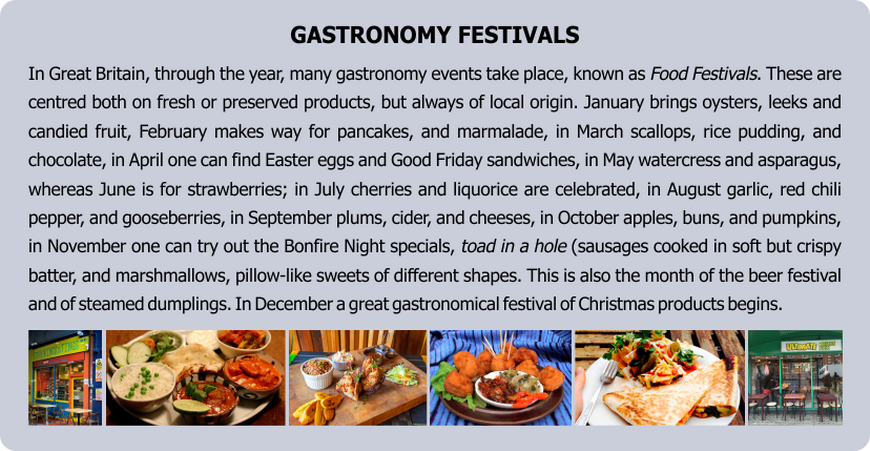
One of the most readily available meals is pie with fish, meat, or vegetables as filling. We can find a vast array, for example steak and kidney pie, with beef and kidneys, or shepherd's pie, which is not strictly speaking a pie as it does not contain pastry but is minced meat covered by a layer of mashed potato with a crusty top baked in the oven, with added spices and vegetables. Others include eel pie, fisb pie, and pork pie. Another category of famous favourites is that of roasted dishes, such as roast beef, roast pork, or roast lamb, either served hot or cold, and not to be forgotten is the meal known in slang as bangers and mash which is made up of sausages with mashed potato and beans… Although it is true that English food has always been associated with meat and fish, there are also a great deal of vegetarian recipes, such as soups, of which there is an endless variety and which really are quite good. Typical examples are based on ingredients such as cauliflower, asparagus, peas, carrots, chestnuts, leeks, water cress, and can be enhanced with ginger, mint, or cheeses.
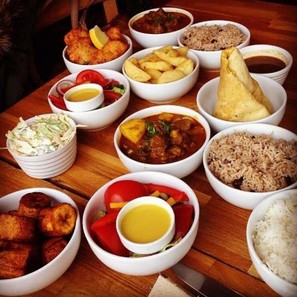 Perhaps the most widespread foreign cuisine to be found in the English capital is Indian food, due to the great number of inhabitants originally from India. Chicken tikka masala, is in fact part of the everyday lifestyle of many English (recently rated as the #1 national dish). There are also many other types of meat cooked with different spices, not to mention the fish. And there is never any shortage of the typical bread from the subcontinent, known as naan bread. In areas like Whitechapel, Aldgate East, Wembley and Southall, as well as many Indian and Pakistani restaurants, there are also shops with important products for sale. In Soho’s Chinatown, surrounding Gerrard Street, but also elsewhere, one can find Chinese cuisine, with the usual Sunday dim sum consisting of spicy chicken, prawns, and vegetables. Also quite present, although not quite so widespread, are the cuisines from Thailand, Mali, and Japan. Sushi bars have become popular in the last few years and restaurants range from very cheap to expensive and refined.
Perhaps the most widespread foreign cuisine to be found in the English capital is Indian food, due to the great number of inhabitants originally from India. Chicken tikka masala, is in fact part of the everyday lifestyle of many English (recently rated as the #1 national dish). There are also many other types of meat cooked with different spices, not to mention the fish. And there is never any shortage of the typical bread from the subcontinent, known as naan bread. In areas like Whitechapel, Aldgate East, Wembley and Southall, as well as many Indian and Pakistani restaurants, there are also shops with important products for sale. In Soho’s Chinatown, surrounding Gerrard Street, but also elsewhere, one can find Chinese cuisine, with the usual Sunday dim sum consisting of spicy chicken, prawns, and vegetables. Also quite present, although not quite so widespread, are the cuisines from Thailand, Mali, and Japan. Sushi bars have become popular in the last few years and restaurants range from very cheap to expensive and refined.As a consequence of immigration from the Middle East, also Lebanese and Curdish restaurants have sprung up, for example in the areas of Bayswater and Edgware Road. Similarly connected to immigration, are Caribbean cuisine and that of Sub-Saharan Africa, especially in areas such as Brixton and Notting Hill. .
